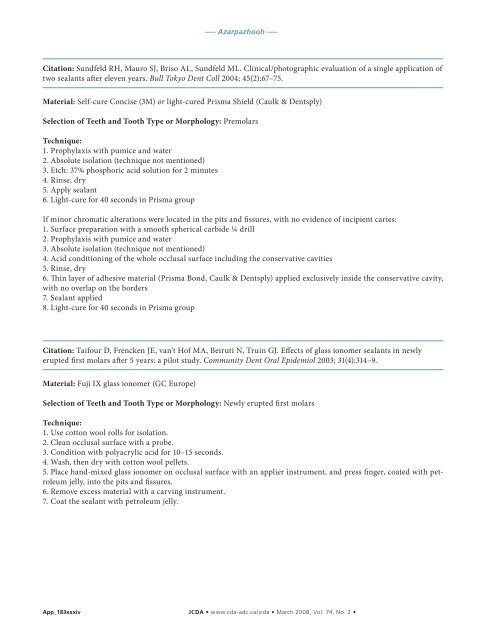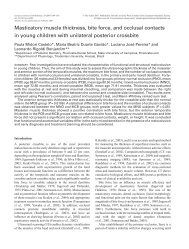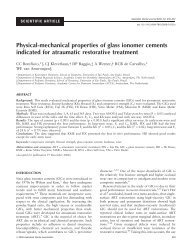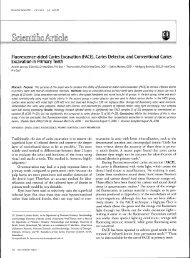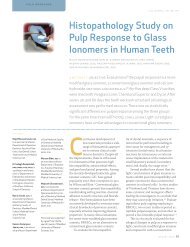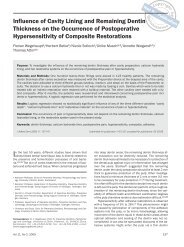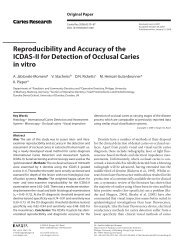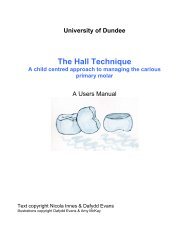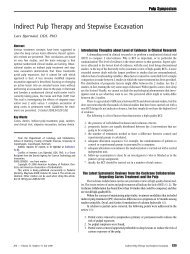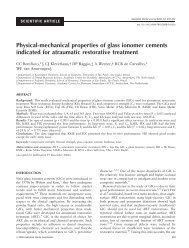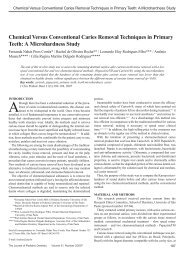Pit and Fissure Sealants in the Prevention of Dental Caries in ...
Pit and Fissure Sealants in the Prevention of Dental Caries in ...
Pit and Fissure Sealants in the Prevention of Dental Caries in ...
You also want an ePaper? Increase the reach of your titles
YUMPU automatically turns print PDFs into web optimized ePapers that Google loves.
––– Azarpazhooh –––<br />
Citation: Sundfeld RH, Mauro SJ, Briso AL, Sundfeld ML. Cl<strong>in</strong>ical/photographic evaluation <strong>of</strong> a s<strong>in</strong>gle application <strong>of</strong><br />
two sealants after eleven years. Bull Tokyo Dent Coll 2004; 45(2):67–75.<br />
Material: Self-cure Concise (3M) or light-cured Prisma Shield (Caulk & Dentsply)<br />
Selection <strong>of</strong> Teeth <strong>and</strong> Tooth Type or Morphology: Premolars<br />
Technique:<br />
1. Prophylaxis with pumice <strong>and</strong> water<br />
2. Absolute isolation (technique not mentioned)<br />
3. Etch: 37% phosphoric acid solution for 2 m<strong>in</strong>utes<br />
4. R<strong>in</strong>se, dry<br />
5. Apply sealant<br />
6. Light-cure for 40 seconds <strong>in</strong> Prisma group<br />
If m<strong>in</strong>or chromatic alterations were located <strong>in</strong> <strong>the</strong> pits <strong>and</strong> fissures, with no evidence <strong>of</strong> <strong>in</strong>cipient caries:<br />
1. Surface preparation with a smooth spherical carbide ¼ drill<br />
2. Prophylaxis with pumice <strong>and</strong> water<br />
3. Absolute isolation (technique not mentioned)<br />
4. Acid condition<strong>in</strong>g <strong>of</strong> <strong>the</strong> whole occlusal surface <strong>in</strong>clud<strong>in</strong>g <strong>the</strong> conservative cavities<br />
5. R<strong>in</strong>se, dry<br />
6. Th<strong>in</strong> layer <strong>of</strong> adhesive material (Prisma Bond, Caulk & Dentsply) applied exclusively <strong>in</strong>side <strong>the</strong> conservative cavity,<br />
with no overlap on <strong>the</strong> borders<br />
7. Sealant applied<br />
8. Light-cure for 40 seconds <strong>in</strong> Prisma group<br />
Citation: Taifour D, Frencken JE, van’t H<strong>of</strong> MA, Beiruti N, Tru<strong>in</strong> GJ. Effects <strong>of</strong> glass ionomer sealants <strong>in</strong> newly<br />
erupted first molars after 5 years: a pilot study. Community Dent Oral Epidemiol 2003; 31(4):314–9.<br />
Material: Fuji IX glass ionomer (GC Europe)<br />
Selection <strong>of</strong> Teeth <strong>and</strong> Tooth Type or Morphology: Newly erupted first molars<br />
Technique:<br />
1. Use cotton wool rolls for isolation.<br />
2. Clean occlusal surface with a probe.<br />
3. Condition with polyacrylic acid for 10–15 seconds.<br />
4. Wash, <strong>the</strong>n dry with cotton wool pellets.<br />
5. Place h<strong>and</strong>-mixed glass ionomer on occlusal surface with an applier <strong>in</strong>strument, <strong>and</strong> press f<strong>in</strong>ger, coated with petroleum<br />
jelly, <strong>in</strong>to <strong>the</strong> pits <strong>and</strong> fissures.<br />
6. Remove excess material with a carv<strong>in</strong>g <strong>in</strong>strument.<br />
7. Coat <strong>the</strong> sealant with petroleum jelly.<br />
App_183xxxiv<br />
JCDA • www.cda-adc.ca/jcda • March 2008, Vol. 74, No. 2 •


